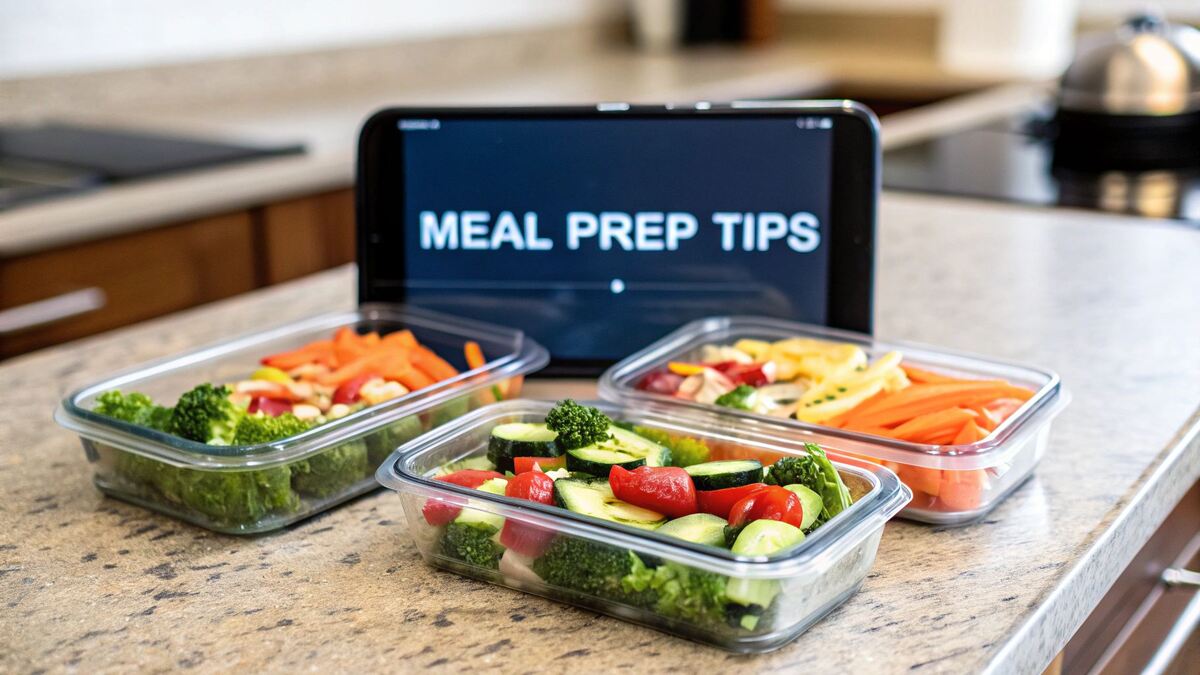8 Essential Meal Prep Tips for Beginners in 2025
Imagine a week where you never have to ask, "What's for dinner?" No more last-minute takeout orders or stressful grocery runs after a long day. This isn't a fantasy, it's the reality of effective meal prep. For many, the idea of preparing a week's worth of food feels overwhelming, reserved for fitness influencers and hyper-organized parents. But it's a skill anyone can master with the right approach.
This guide is designed to dismantle that overwhelm. We've compiled a collection of practical, actionable meal prep tips for beginners that will build your confidence and help you create a system that actually sticks. You will learn how to start small, avoid common pitfalls, and organize your kitchen for maximum efficiency.
We'll cover everything from choosing the right recipes and investing in quality containers to mastering batch cooking and prepping individual ingredients instead of full meals. We will also show you how to leverage smart tools like the AI Meal Planner to streamline the entire process. Our goal is to transform a dreaded chore into a satisfying weekly ritual that saves you significant time, money, and stress, putting you back in control of your meals and your schedule.
1. Start Small and Simple
Diving into meal prep can feel like a monumental task, especially when you see elaborate, seven-day spreads on social media. The most common mistake beginners make is trying to do too much, too soon. This all-or-nothing approach often leads to burnout, food waste, and the feeling that meal prep is simply too hard. The solution is to embrace a foundational principle championed by experts like Beth Moncel of Budget Bytes: start small and keep it simple. This is one of the most crucial meal prep tips for beginners because it builds a sustainable habit rather than a short-lived, stressful effort.
Instead of prepping 21 meals for the entire week, focus on a manageable goal. This could mean prepping just breakfasts and lunches for three workdays or batch-cooking a single recipe to cover four dinners. By reducing the scope, you lower the pressure and make the process feel achievable. This strategy helps you master the basic skills of planning, cooking in bulk, and storing food correctly without becoming overwhelmed.
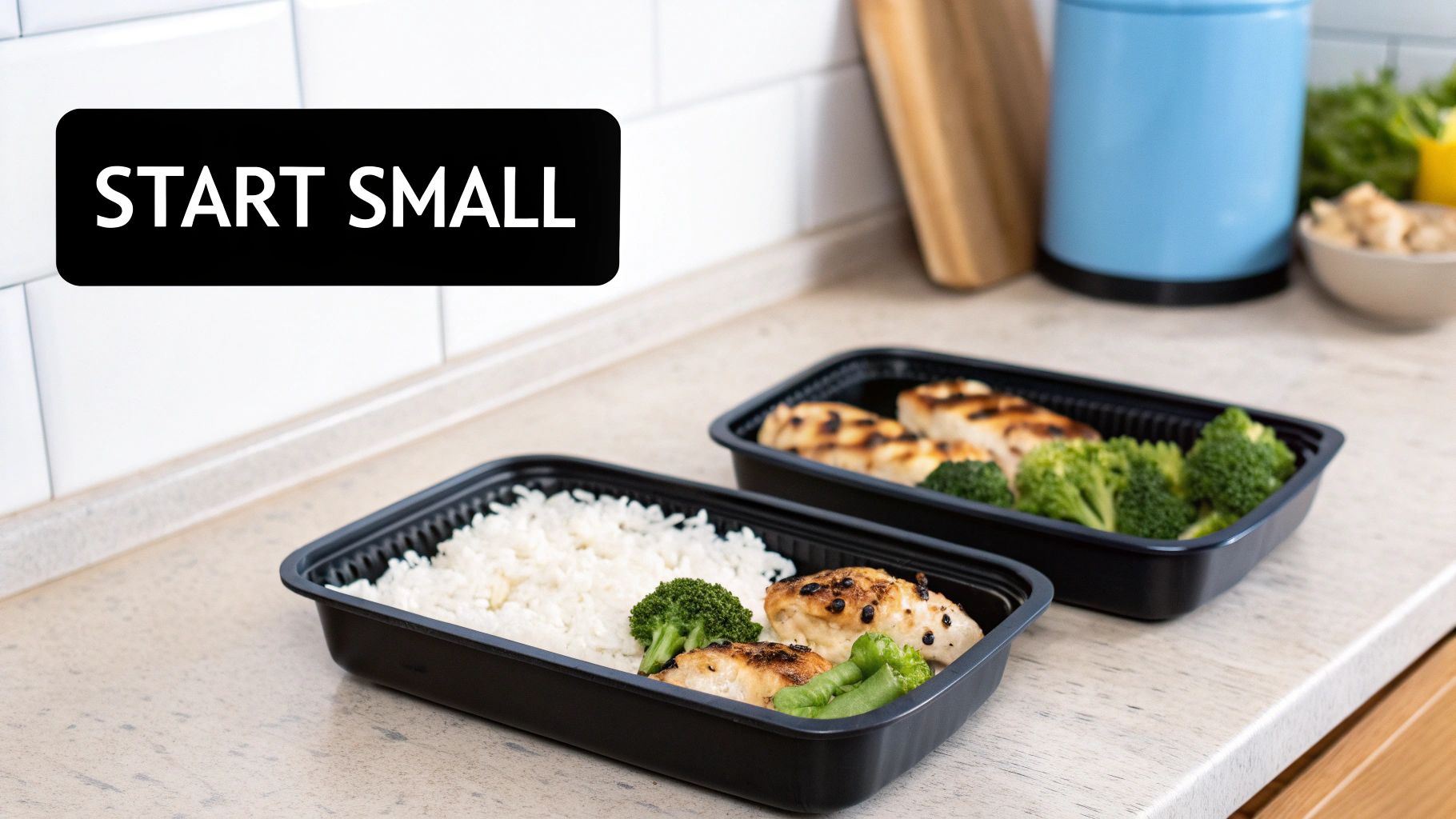
How to Implement This Strategy
To put this into practice, choose one area to focus on for your first prep session. The goal is to create a small win that builds confidence.
- Component Prep: Don't prep full meals. Instead, cook a large batch of one versatile protein (like shredded chicken), one carbohydrate (like quinoa or brown rice), and chop a few vegetables (like bell peppers and onions). You can then mix and match these components throughout the week.
- Meal-Specific Prep: Tackle the meal that causes you the most stress. If chaotic mornings are your pain point, spend 30 minutes prepping a few days' worth of overnight oats or breakfast burritos.
- The "2x2" Method: Prepare just two different meals for two days each. For example, make a large batch of chili for Monday and Tuesday's lunch, and a simple chicken and veggie stir-fry for Wednesday and Thursday's lunch.
By starting small, you learn your own rhythm: how long it actually takes to chop veggies, what containers work best, and which recipes hold up well. This hands-on experience is invaluable and sets the stage for gradually expanding your prep as you become more comfortable and efficient.
2. Invest in Quality Storage Containers
The quality of your food storage containers is the unsung hero of meal prep. It directly impacts food freshness, portion control, safety, and convenience. Using a mismatched collection of flimsy takeout containers or containers that leak can lead to spoiled food, messy bags, and frustration, quickly derailing your meal prep efforts. Investing in a reliable set of containers is one of the most practical meal prep tips for beginners because it creates a functional system that protects the time and effort you put into cooking.
Proper containers ensure your meals remain appetizing and fresh throughout the week. Brands like Prep Naturals and meal planning services like Prep Dish emphasize the importance of using leak-proof, microwave-safe, and appropriately sized containers. Glass options are fantastic for durability and reheating without staining or retaining odors, while high-quality BPA-free plastic offers a lightweight, portable alternative perfect for on-the-go lunches. Having the right tools makes the entire process of storing, transporting, and eating your prepped meals effortless and enjoyable.
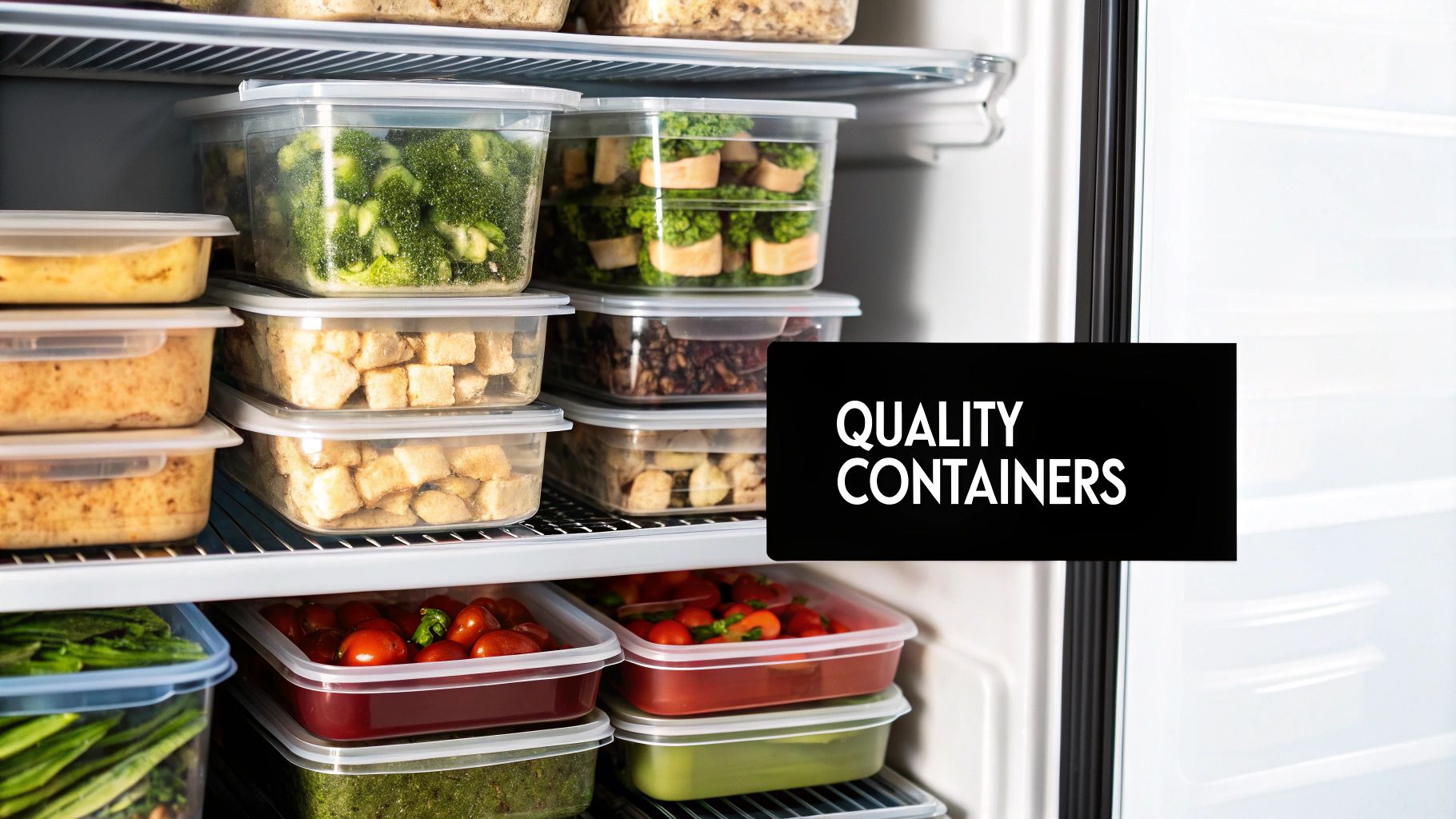
How to Implement This Strategy
To build a functional container collection, start with the essentials and choose options that fit your specific meal types. The goal is to make your food as easy to grab and eat as possible.
- Choose the Right Material: Start with a mix. Get a few durable glass containers (like Pyrex) for meals you’ll reheat at home or in the office. Supplement with lightweight, BPA-free plastic containers (like Rubbermaid Brilliance) for salads, snacks, and cold lunches. When considering specific tools to aid your routine, a specialized item like the Swell Salad Bowl Kit can simplify your on-the-go meal solutions.
- Prioritize Shape and Size: Opt for square or rectangular containers over round ones, as they stack more efficiently and maximize space in your fridge and freezer. Start with a set of 5-7 containers in the size you’ll use most often for main meals.
- Compartmentalize Your Meals: For dishes with sauces, dressings, or components you want to keep separate, use containers with built-in dividers. This prevents soggy salads and ensures components like chicken and rice don't blend together before you're ready to eat.
- Test for Quality: Before committing to a full set, test a container's seal. Fill it with water, secure the lid, and shake it upside down. A truly leak-proof seal is non-negotiable for transporting soups, stews, and dressings.
3. Choose One Prep Day and Stick to It
The secret to making meal prep a lasting part of your routine isn't having the perfect containers or the most complex recipes; it's consistency. Establishing a dedicated prep day transforms meal prep from a sporadic, stressful chore into a non-negotiable, automated habit. As habit formation expert James Clear explains in his book Atomic Habits, making a behavior obvious, attractive, easy, and satisfying is key to sticking with it. By designating a specific time each week, you make the habit obvious and easy to integrate into your life. This is one of the most effective meal prep tips for beginners because it builds the foundational discipline required for long-term success.
Choosing a consistent day allows you to structure your entire week around it. You can plan your grocery shopping for the day before, clear your schedule, and mentally prepare for the task ahead. Whether it’s a leisurely Sunday afternoon or a focused Wednesday evening, treating this time as an important appointment with yourself is crucial. This routine removes the daily guesswork of "what's for dinner?" and significantly reduces decision fatigue, freeing up mental energy for other priorities throughout the week.
The following concept map illustrates how dedicating a specific prep day fosters a sustainable meal prep habit.
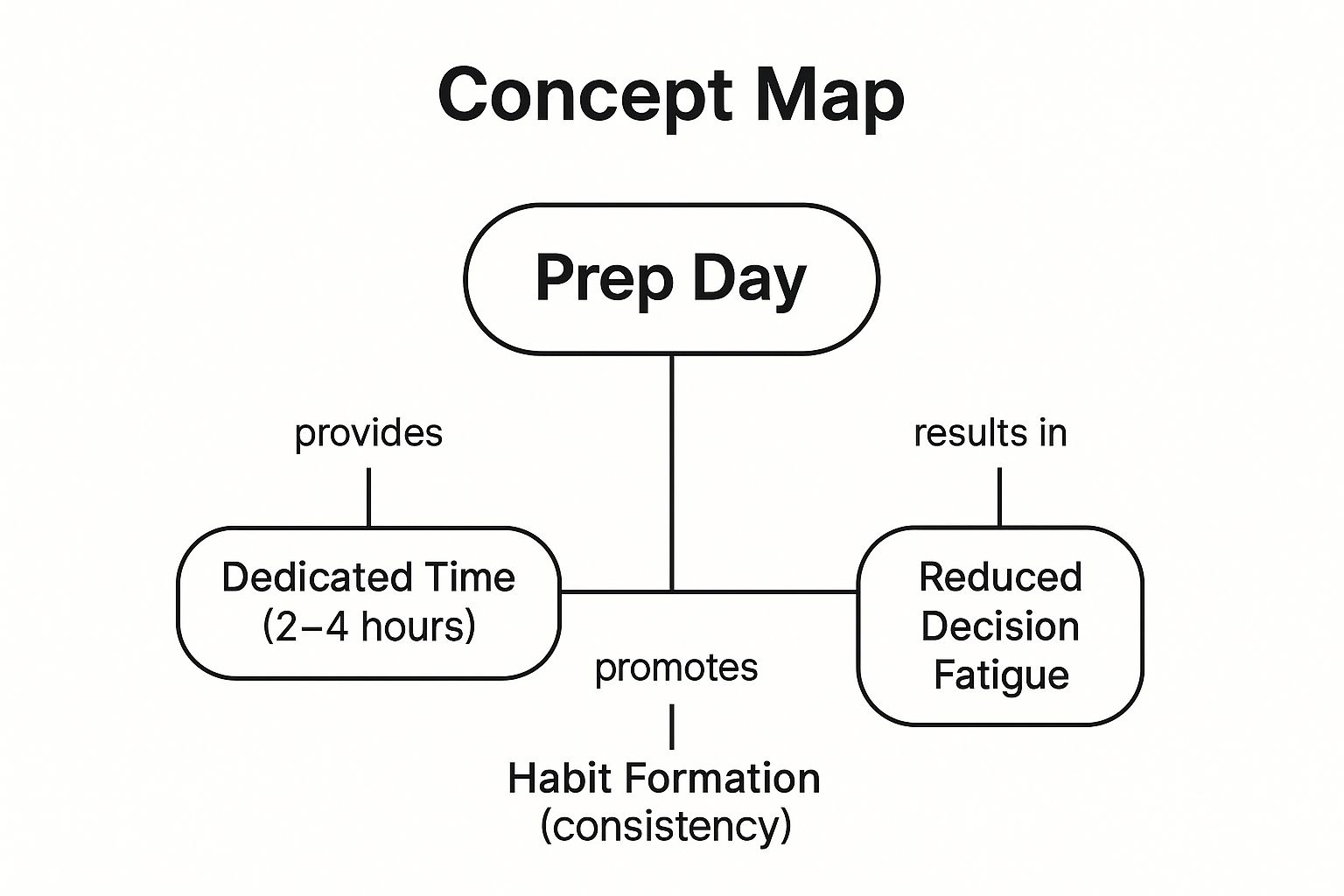
This visual highlights how setting aside dedicated time directly contributes to habit formation and a reduction in daily mental load, making your week smoother.
How to Implement This Strategy
To make your chosen prep day stick, integrate it into your weekly schedule and protect that time fiercely. The goal is to make it as automatic as brushing your teeth.
- Schedule and Remind: Pick a 2 to 3-hour time slot when you typically have the most energy. Block it off in your calendar and set a reminder for the day before to ensure you have all your groceries ready.
- The Sunday Standard: Dedicate Sunday afternoon to prepping. This is the most popular choice as it sets you up for a smooth and stress-free start to the work week.
- The Mid-Week Refresh: If you prefer fresher meals or have a less conventional schedule, try a "split prep." Cook proteins and grains on Sunday, then do a quick 60-minute session on Wednesday evening to chop fresh veggies or assemble salads for the rest of the week.
- Make it Enjoyable: Create a positive association with your prep time. Turn on your favorite podcast, listen to an energizing playlist, or invite a family member to help. The more you enjoy the process, the more likely you are to continue it.
By committing to a specific day, you are not just cooking food; you are building a powerful system that supports your health goals, saves you time, and simplifies your entire week. This consistency is the engine that drives a successful meal prep routine.
4. Master the Mix-and-Match Method
One of the biggest complaints about meal prep is the monotony of eating the same exact meal day after day. This is where the mix-and-match method, also known as "modular meal prep," becomes a game-changer. Instead of preparing five identical containers of chicken, broccoli, and rice, you prepare individual components: proteins, carbohydrates, vegetables, and sauces. This approach, popularized by fitness communities and build-your-own-bowl restaurants, prevents flavor fatigue by giving you the flexibility to assemble different meals throughout the week. This is one of the most effective meal prep tips for beginners because it combines the efficiency of batch cooking with the variety of making a fresh meal every day.
By prepping versatile ingredients separately, you can easily create a Mediterranean bowl on Monday, a taco salad on Tuesday, and a teriyaki stir-fry on Wednesday, all using the same core prepped components. This method empowers you to adjust portions and combinations based on your daily cravings and hunger levels, making your meal plan feel less restrictive and more intuitive. It’s the perfect strategy for anyone who gets bored easily but still wants to save time and stay on track with their health goals.
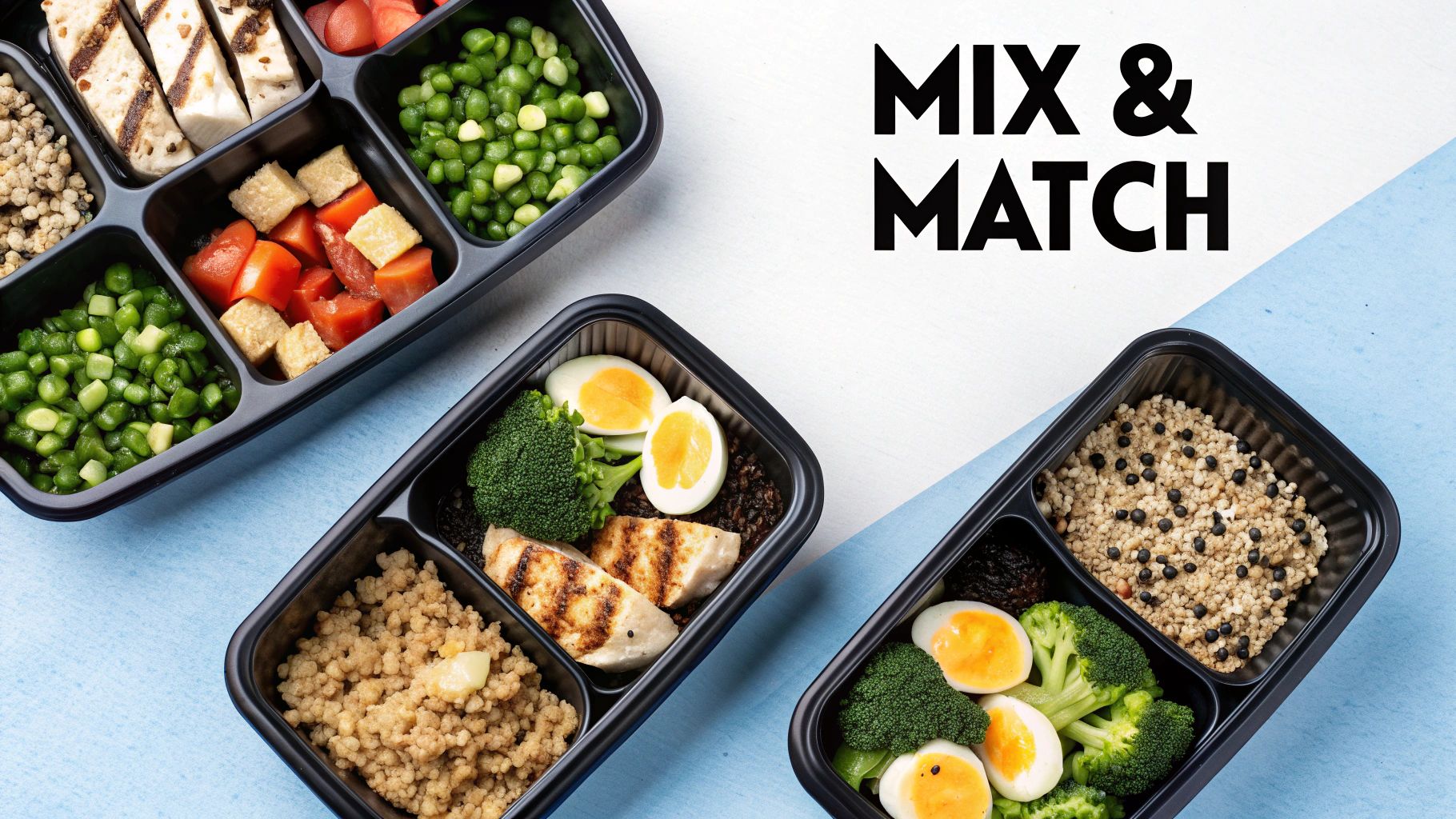
How to Implement This Strategy
To get started, focus on prepping a small but varied selection of components. The key is choosing ingredients that can be used across multiple flavor profiles.
- Build Your Base: Aim to prep at least two proteins (shredded chicken, ground turkey), two carbohydrates (quinoa, sweet potatoes), and three vegetables (roasted broccoli, sautéed bell peppers, chopped romaine). This creates enough variety for a standard work week.
- Embrace Sauces: The secret to variety is in the sauce. Prep two or three different dressings or sauces, like a chimichurri, a peanut sauce, or a simple vinaigrette. Store them separately in small jars to prevent your main ingredients from getting soggy.
- Create a "Component Matrix": A simple chart can help you visualize the possibilities. List your proteins, carbs, and veggies in columns and rows to see how many different combinations you can create. For example, your seasoned ground turkey can be used in a taco bowl with rice and peppers or mixed with quinoa and roasted broccoli for a simple grain bowl.
This modular approach not only keeps your meals interesting but also helps reduce food waste, as you can easily use up leftover components in new and creative ways. It's a sustainable system that adapts to your needs.
5. Use Batch Cooking Techniques Efficiently
Once you're comfortable with the basics, the next step is to make your prep sessions faster and more productive. Batch cooking is the art of using multiple kitchen appliances and cooking methods simultaneously to prepare several meal components at once. Instead of cooking one dish from start to finish, you create an assembly line in your kitchen, dramatically reducing your total time commitment. This is one of the most powerful meal prep tips for beginners because it transforms a potentially lengthy task into a highly efficient 2-3 hour session.
The core principle is to maximize your active and passive cooking times. While a protein is baking in the oven, you can cook grains on the stovetop, steam veggies, or use an Instant Pot for another component. For efficient batch cooking, having the right tools is essential; if you're looking to upgrade your setup, consider checking out this guide to choosing kitchen appliances. By overlapping tasks and eliminating downtime, you get more food prepped in less time, making the entire process feel more manageable and less like a chore.

How to Implement This Strategy
To avoid kitchen chaos, approach batch cooking with a clear plan. The goal is to create a workflow that keeps you moving without feeling overwhelmed.
- Create a Timeline: Before you start, jot down a quick schedule. Start with the item that takes the longest to cook (like a roast or brown rice) and plan shorter tasks around its cooking time.
- The "Oven + Stovetop" Combo: This is a classic starting point. While chicken thighs and chopped sweet potatoes roast on a sheet pan in the oven, boil eggs and cook a batch of quinoa on the stovetop.
- Leverage All Your Tools: Put your slow cooker, Instant Pot, and oven to work at the same time. You can have pulled pork in the slow cooker, hard-boiled eggs in the Instant Pot, and roasted vegetables in the oven, all cooking simultaneously with minimal hands-on effort. This is an excellent strategy for preparing a variety of high-protein meal components.
- Clean as You Go: Use passive cooking time (when food is in the oven or simmering) to wash dishes, wipe counters, and put away ingredients. This small habit prevents a massive cleanup job at the end.
6. Keep a Rotating Recipe Collection
One of the biggest hurdles in weekly planning is "decision fatigue" - the exhaustion from simply deciding what to make. Reinventing the wheel every week with new, untested recipes can lead to stress, forgotten ingredients, and inconsistent results. A powerful strategy to combat this is to curate and maintain a rotating collection of proven meal prep recipes. This approach, popularized by platforms like Workweek Lunch and organizational apps, focuses on repetition and mastery over constant novelty, a key principle for sustainable meal prep.
This method involves building a personal library of 10-15 recipes that you know work well for prepping, that you enjoy eating, and that you can cook efficiently. Instead of searching endlessly for new ideas, you pull from this trusted list, rotating dishes every few weeks to prevent boredom. This is one of the most effective meal prep tips for beginners because it creates a reliable system, streamlines grocery shopping, and guarantees you'll have meals you genuinely look forward to eating. It turns meal prep from a weekly puzzle into a simple, repeatable process.
How to Implement This Strategy
Creating your recipe collection is a gradual process focused on building a reliable foundation. The goal is to have a go-to list that removes guesswork from your planning sessions.
- Start with Your Staples: Begin by identifying 3-5 recipes you already know and love. These could be a favorite chili, a simple baked chicken, or a pasta salad. Document them in one place, whether it's a digital app like Paprika, a physical binder, or a simple spreadsheet.
- Test and Add Gradually: When you want to try something new, cook it on a non-prep day first. If it's a winner and holds up well as leftovers, add it to your collection. Note any modifications you made, its storage life, and how long it took to prepare.
- Organize for Efficiency: Structure your collection in a way that makes planning easy. You can use a Pinterest board organized by protein (chicken, beef, vegetarian), a Notion database with tags for cuisine or prep time, or a simple recipe box with notecards.
- Strategic Rotation: Plan your meals by picking 2-3 recipes from your collection each week. To keep things interesting, rotate them out every 2-3 weeks and review your entire collection seasonally to incorporate ingredients like squash in the fall or fresh berries in the summer.
7. Prep Ingredients, Not Just Complete Meals
The idea of eating the same pre-portioned meal several days in a row can be a major turn-off for many beginners. If you crave variety or simply enjoy the process of cooking, a full meal prep can feel restrictive and lead to "flavor fatigue." The solution is to adopt the "mise en place" strategy used by professional chefs: prep ingredients, not fully assembled meals. This approach, often called component prep, offers the perfect balance between efficiency and flexibility.
This method is one of the most versatile meal prep tips for beginners because it streamlines the daily cooking process without locking you into a specific dish. You do all the time-consuming tasks like chopping, marinating, and batch-cooking grains upfront. When it's time to eat, you simply assemble these ready-to-go components into fresh, creative meals in minutes. It eliminates the tedious prep work while preserving the enjoyment of cooking and eating something new each day.

How to Implement This Strategy
To start with ingredient prep, think in terms of versatile components that can be mixed and matched. The goal is to create a toolkit of ready-to-use foods that can form the base of various meals.
- Create "Starter Kits": Group ingredients for specific meal types together. For example, a "stir-fry kit" could contain chopped bell peppers, broccoli, and onions in one container, with marinated chicken in another. This makes pulling together a quick dinner incredibly fast.
- Batch Cook Grains and Proteins: Cook a large batch of a neutral grain like quinoa or brown rice. Separately, cook a versatile protein like shredded chicken or ground turkey. These can be added to salads, bowls, or tacos throughout the week.
- Wash and Chop Vegetables: Dedicate time to washing and chopping hardy vegetables like carrots, bell peppers, broccoli, and onions. Store them in airtight containers, sometimes with a damp paper towel to maintain crispness. This small step makes adding veggies to any meal effortless.
This component-based method ensures you save significant time while still having control over your daily meals. For help planning which ingredients to prep for a varied week, you can learn more about how an AI-powered meal planner can generate shopping lists based on your component prep goals.
8. Plan Your Meals Around Your Schedule
One of the biggest pitfalls in meal prepping is creating a plan for an idealized version of your life, not the one you actually live. Successful, sustainable meal prep requires an honest look at your real-world schedule, energy levels, and daily commitments. As authors like Gretchen Rubin emphasize, understanding your personal tendencies is key to building habits that stick. This is one of the most practical meal prep tips for beginners because it shifts the focus from a generic template to a truly personalized system.
A plan that doesn’t account for your late work nights, kids' soccer practices, or access to a microwave is destined to fail. Instead of forcing yourself into a rigid, one-size-fits-all prep routine, design your prep around your life's unique rhythm. This approach prevents food waste, reduces decision fatigue, and ensures your prepped meals are a convenient solution rather than an unused burden in the back of the fridge.
How to Implement This Strategy
To make your meal prep plan work for you, start by analyzing your typical week. Be realistic about your habits and obligations to build a plan that truly supports your lifestyle.
- Audit Your Week: Before you cook anything, track your schedule and eating habits for a few days. Note when you're busiest, when your energy is lowest, and which meals are most stressful. A nurse working 12-hour shifts might need easy-to-eat cold lunches and high-energy snacks, while an office worker can plan for microwave-reheatable bowls.
- Prioritize Pain Points: Don't try to prep for every single meal. Identify the 2-3 days or meal times that cause the most chaos. If dinners are your downfall, focus your energy there. If you always skip breakfast, prep something portable.
- Match Meals to Your Reality: Be practical. If you travel frequently for work, maybe you only prep breakfasts and snacks. If you know you'll be exhausted on Thursday nights, plan for a simple "assembly-only" meal like a pre-chopped salad or a grain bowl with pre-cooked components. This is where a service that creates personalized meal plans can be a game-changer; discover more about custom meal plans for your schedule.
By aligning your meal prep with your actual schedule, you create a system that reduces stress instead of adding to it. This personalized approach is the key to turning meal prep from a weekly chore into a lasting, beneficial habit.
8 Key Meal Prep Tips Comparison
| Item | Implementation Complexity 🔄 | Resource Requirements ⚡ | Expected Outcomes 📊 | Ideal Use Cases 💡 | Key Advantages ⭐ |
|---|---|---|---|---|---|
| Start Small and Simple | Low: Basic recipes with minimal steps | Low: Few ingredients, simple cookware | Builds confidence, reduces overwhelm | Beginners, busy professionals | Minimizes waste, reduces decision fatigue |
| Invest in Quality Storage Containers | Medium: Selecting and maintaining proper containers | Medium: Investment in good containers | Maintains freshness, improves portion control | Anyone wanting organized, fresh meal storage | Extends food life, prevents leaks and contamination |
| Choose One Prep Day and Stick to It | Medium: Requires scheduling consistent weekly block | Low: Time commitment, minimal extra tools | Creates habit, reduces decision fatigue | Those needing routine and habit formation | Builds consistency, improves time management |
| Master the Mix-and-Match Method | Medium-High: Planning components separately | Medium-High: Multiple containers needed | Flexible meals, reduces boredom | Those seeking meal variety and customization | Variety without cooking full meals daily |
| Use Batch Cooking Techniques Efficiently | High: Coordination of multiple cooking methods | High: Multiple appliances and equipment | Significant time savings, efficient workflow | Experienced cooks, time-constrained preppers | Reduces total prep time, maximizes appliance use |
| Keep a Rotating Recipe Collection | Medium: Curating and documenting recipes | Low-Medium: Access to recipes/tools | Eliminates decision fatigue, consistency in quality | Those who want reliable go-to meals and variety | Simplifies planning, improves prep speed |
| Prep Ingredients, Not Just Complete Meals | Medium: Partial prep, daily finishing required | Medium: Prep tools, fridge space | Fresher meals, flexible eating options | People who enjoy cooking, flexible schedules | Maintains freshness, reduces monotony |
| Plan Your Meals Around Your Schedule | Medium: Requires honest schedule assessment | Low: Planning and tracking tools | Sustainable, realistic meal prep | Anyone needing meal prep aligned with real-life | Reduces waste, improves adherence |
Your First Step to a Simpler Week Starts Now
Embarking on the meal prep journey can feel like a significant undertaking, but as we've explored, it's not about achieving culinary perfection overnight. It's about building a sustainable system, one simple habit at a time, that frees up your time, reduces stress, and puts you firmly in control of your health goals. By implementing these foundational meal prep tips for beginners, you are creating a powerful framework for success.
The key is to move from theory to action. This week, don't try to implement everything at once. Instead, focus on one or two strategies that resonate most with your lifestyle. Perhaps it's simply investing in quality containers or choosing one day to dedicate just two hours to batch-cooking a protein and chopping some vegetables. These small, consistent efforts are the building blocks of a lasting routine.
Key Takeaways for Your Meal Prep Journey
Let's quickly recap the core principles that will make the biggest impact as you start out:
- Start Small, Win Big: The goal is consistency, not complexity. Begin by prepping just a few lunches or a single dinner for the week. Small victories build momentum and confidence.
- Plan for Your Real Life: Your meal plan should serve your schedule, not the other way around. Acknowledge busy nights and social events, and plan for quick meals or intentional leftovers on those days.
- Prep Smart, Not Hard: Focus on versatile components. Prepping ingredients like chopped onions, cooked quinoa, and grilled chicken allows for mix-and-match meals, preventing flavor fatigue and offering flexibility.
Mastering these beginner meal prep tips does more than just fill your fridge; it fundamentally changes your relationship with food and time. It eliminates the daily "what's for dinner?" scramble, reduces impulsive takeout orders, and ensures you always have a nutritious, delicious option ready to go. You're not just preparing meals; you're investing in your future self, giving them the gift of more time, less stress, and better health. The initial effort pays dividends all week long, empowering you to meet your fitness, weight loss, or wellness goals with greater ease and enjoyment. Your journey to a more organized, healthier lifestyle begins with that first chopped vegetable, that first planned meal. Take that step today.
Ready to eliminate the guesswork and create a perfect plan in seconds? The AI Meal Planner uses advanced technology to generate personalized meal plans, complete with recipes and organized shopping lists, tailored to your unique dietary needs and goals. Stop stressing and start prepping with the ultimate tool for beginner success.
Discover your personalized meal plan with AI Meal Planner today!
AI-powered nutrition
Get Your Personalized Meal Plan
AI creates the perfect meals for your goals, lifestyle, and taste.
Start Your Journej
